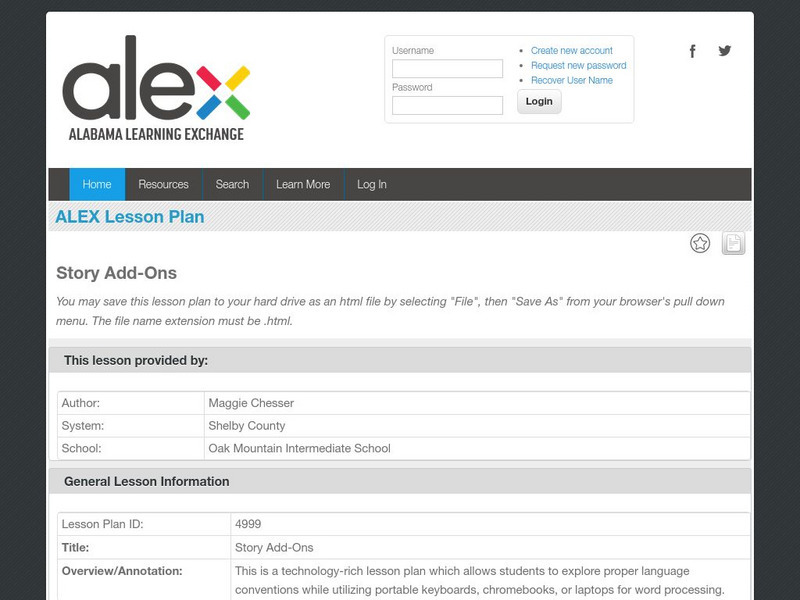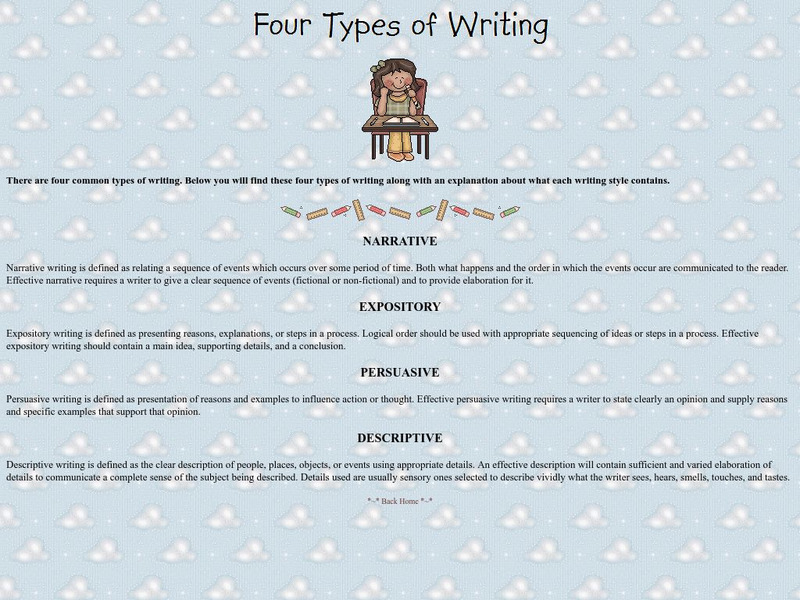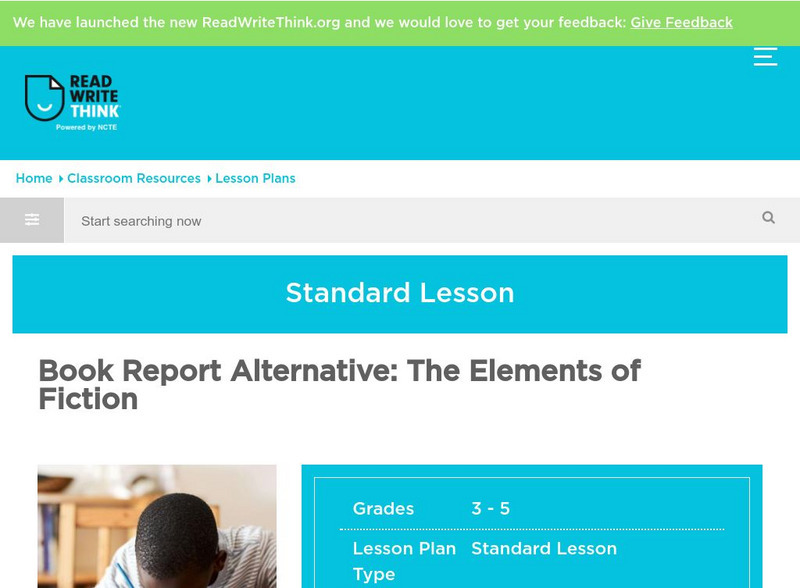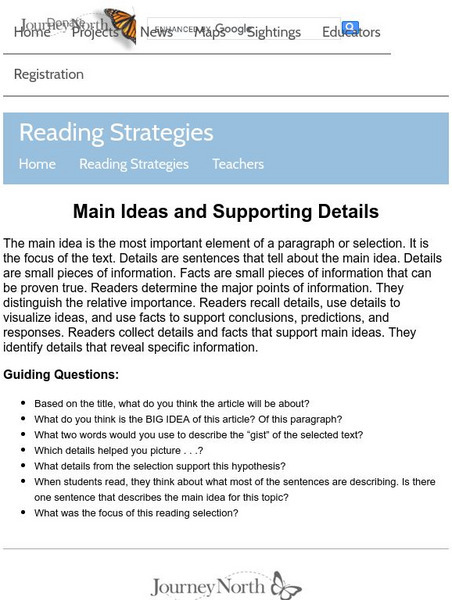Scholastic
Scholastic Instructor: Puzzled Over Paragraphs?
Here is an excellent list of ideas for teachers to utilize in their classroom to accompany paragraph writing skills. These creative and exciting activities will sharpen your student's writing abilities.
Alabama Learning Exchange
Alex: Better Living Through Science
This lesson involves research on scientists whose accomplishments have impacted areas of nutrition, sanitation, or health care. Students will research an area of their choice, record information on a graphic organizer, and use the...
Alabama Learning Exchange
Alex: Narrative Paragraphs
Learners learn to use a one-main idea Think-sheet for producing a narrative paragraph. [Requires Adobe Reader.]
Alabama Learning Exchange
Alex: Writing to Determine, "What Is a Pulgar?"
This lesson plan is a writing follow-up to the guided reading lesson plan, "What is a Pulgar?" It utilizes a Makes Sense Strategies Think-sheet to guide the writing.
Alabama Learning Exchange
Alex: "How to Build a Snowman" Expository Writing
During this lesson, 4th graders begin to understand how important specific directions are to a project. Students will demonstrate detailed writing in order to instruct their classmates on how to build a snowman.
South Carolina Educational Television
Know It All: Using Figurative Language to Shape Meaning and Style
The students will be able to identify different types of figurative language in a story and explain how the author uses figurative language to shape the meaning and style of the story.
Alabama Learning Exchange
Alex: Story Add Ons
This is a technology-rich lesson plan which allows students to explore proper language conventions while utilizing portable keyboards for word processing.
Josie's Poems
Josie's Poems: "Expressing Ourselves"
A poem about how animals communicate and how humans are different because of the way we can communicate.
Beacon Learning Center
Beacon Learning Center: Web Lessons: Get the Main Idea
This resource provides practice finding the main idea by having students read a paragraph and choose the main idea. Then it asks students to take what they have learned and apply it to a book of their choice, and then write a paragraph...
Other
Noodle Tools: Basic Language Literacy: Writing: Paragraph Art
When you create a coherent paragraph, it can be represented by any number of visual images. This page shows examples of how that might work to help writers understand the idea of coherence.
ACT360 Media
Writing Den: Supporting Details
A short explanation and example of supporting sentences, what they do, and how to write them.
Other
Ccss Literacy E Handbook: Informational Text: Use Details and Examples
A short explanation of how to use explicit details in an informational text to make inferences. Click on Model at the bottom right to see a model with examples.
Other
Ccss Literacy E Handbook: Informational Text: Summarize
A short explanation of how summarize an informational text. Click on the Model link to see an example summary with explanation.
Other
Ccss Literacy E Handbook: Informational Text: Understand Precise Vocabulary
A short explanation of the importance of using precise word choice in writing and using context clues to help you understand the meaning of precise words when reading. Click on Model to for an example with explanation and then click on...
Other
Ccss Literacy E Handbook: Informational Text: Understand Content Words
A short example of using context clues to determine the meaning of unfamiliar content words. Click on Practice to practice using context clues.
Other
Ccss Literacy E Handbook: Informational Text: Compare Perspectives
A short explanation of the difference between a firsthand account and a secondhand account.
Other
Ccss Literacy E Handbook: Informational Text: Reasons and Evidence in Text
A short explanation of using reasons and evidence as supporting details. Click the link to see a model of how to identify reasons and evidence in an informational text. Click on the Model button on the bottom right to see a model.
Other
Sanchezclass.com: Four Types of Writing
Definitions of the four types of writing: narrative, expository, persuasive, and descriptive.
ReadWriteThink
Read Write Think: Book Report Alternative: The Elements of Fiction
Analyzing a book takes the form of creating their own when students complete this activity. The stated goal is to help students "Read like writers." Includes link to a template for student use.
Quia
Quia: Metaphor Quiz
Read five short paragraphs and choose the main idea of each. Check the answers when finished to see how many were right.
Other
Hickman Community Charter District: Informative Writing
Sample topics in informative writing for K-3rd grades and 4th-8th grades. CSS.ELA-Literacy.CCRA.W.2. CCSS.ELA-Literacy.WHST.6-8.9 Draw evidence from informational texts to support analysis, reflection, and research.
Annenberg Foundation
Annenberg Learner: Journey North: Reading Strategies: Main Ideas and Supporting Details
Learn how to identify the main ideas and supporting details in an informational text by using a list of guiding questions.
Other
Cyberwriter: Descriptive Writing
Resource gives writing activities leveled K-1st grade, 2nd & 3rd grades and 4th through 8th grades.
Other
Strategies for Reading Comprehension:reciprocal Teaching
Use this page to understand the reciprocal teaching strategy that includes the role of the clarifier in student groups.





















